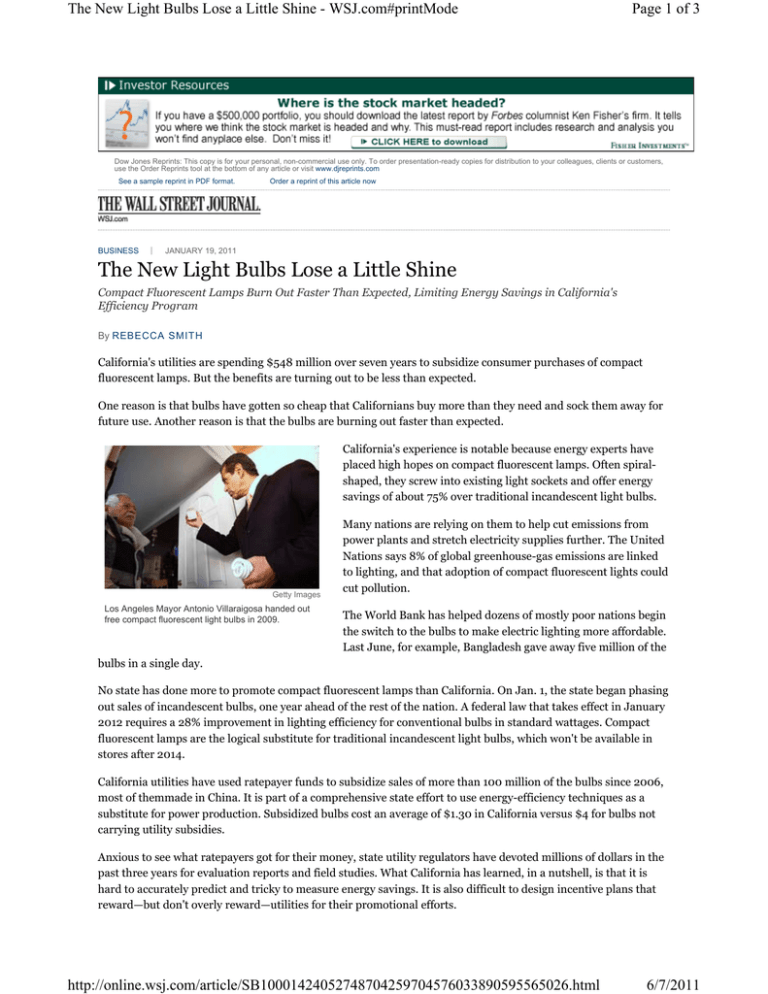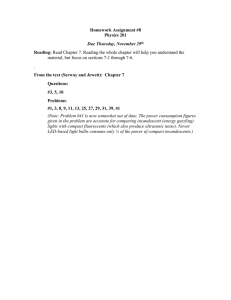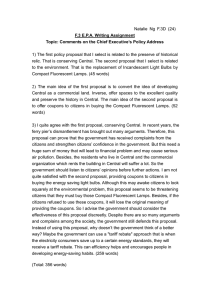
The New Light Bulbs Lose a Little Shine - WSJ.com#printMode
Page 1 of 3
Dow Jones Reprints: This copy is for your personal, non-commercial use only. To order presentation-ready copies for distribution to your colleagues, clients or customers,
use the Order Reprints tool at the bottom of any article or visit www.djreprints.com
See a sample reprint in PDF format.
BUSINESS
Order a reprint of this article now
JANUARY 19, 2011
The New Light Bulbs Lose a Little Shine
Compact Fluorescent Lamps Burn Out Faster Than Expected, Limiting Energy Savings in California's
Efficiency Program
By REBECCA SMITH
California's utilities are spending $548 million over seven years to subsidize consumer purchases of compact
fluorescent lamps. But the benefits are turning out to be less than expected.
One reason is that bulbs have gotten so cheap that Californians buy more than they need and sock them away for
future use. Another reason is that the bulbs are burning out faster than expected.
California's experience is notable because energy experts have
placed high hopes on compact fluorescent lamps. Often spiralshaped, they screw into existing light sockets and offer energy
savings of about 75% over traditional incandescent light bulbs.
Getty Images
Los Angeles Mayor Antonio Villaraigosa handed out
free compact fluorescent light bulbs in 2009.
Many nations are relying on them to help cut emissions from
power plants and stretch electricity supplies further. The United
Nations says 8% of global greenhouse-gas emissions are linked
to lighting, and that adoption of compact fluorescent lights could
cut pollution.
The World Bank has helped dozens of mostly poor nations begin
the switch to the bulbs to make electric lighting more affordable.
Last June, for example, Bangladesh gave away five million of the
bulbs in a single day.
No state has done more to promote compact fluorescent lamps than California. On Jan. 1, the state began phasing
out sales of incandescent bulbs, one year ahead of the rest of the nation. A federal law that takes effect in January
2012 requires a 28% improvement in lighting efficiency for conventional bulbs in standard wattages. Compact
fluorescent lamps are the logical substitute for traditional incandescent light bulbs, which won't be available in
stores after 2014.
California utilities have used ratepayer funds to subsidize sales of more than 100 million of the bulbs since 2006,
most of themmade in China. It is part of a comprehensive state effort to use energy-efficiency techniques as a
substitute for power production. Subsidized bulbs cost an average of $1.30 in California versus $4 for bulbs not
carrying utility subsidies.
Anxious to see what ratepayers got for their money, state utility regulators have devoted millions of dollars in the
past three years for evaluation reports and field studies. What California has learned, in a nutshell, is that it is
hard to accurately predict and tricky to measure energy savings. It is also difficult to design incentive plans that
reward—but don't overly reward—utilities for their promotional efforts.
http://online.wsj.com/article/SB10001424052748704259704576033890595565026.html
6/7/2011
The New Light Bulbs Lose a Little Shine - WSJ.com#printMode
Page 2 of 3
When it set up its bulb program in 2006, PG&E Corp. thought its customers would buy 53 million compact
fluorescent bulbs by 2008. It allotted $92 million for rebates, the most of any utility in the state. Researchers
hired by the California Public Utilities Commission concluded earlier this year that fewer bulbs were sold, fewer
were screwed in, and they saved less energy than PG&E anticipated.
As a result of these and other adjustments, energy savings attributed to PG&E were pegged at 451.6 million
kilowatt hours by regulators, or 73% less than the 1.7 billion kilowatt hours projected by PG&E for the 2006-2008
program.
One hitch was the compact-fluorescent burnout rate.
When PG&E began its 2006-2008 program, it figured
the useful life of each bulb would be 9.4 years. Now,
with experience, it has cut the estimate to 6.3 years,
which limits the energy savings. Field tests show higher
burnout rates in certain locations, such as bathrooms
and in recessed lighting. Turning them on and off a lot
also appears to impair longevity.
California regulators have debated whether utilities
should be held to the energy savings they promised in
order to earn bonus pay. Staff of the state utilities
commission said utilities missed their overall-energy
savings targets, partly because of disappointing results
from light bulbs. Utilities disagree with many of the
staff's conclusions.
Steve Malnight, vice president of energy-efficiency programs at PG&E, said the researchers "lost sight of the fact
that utilities have produced tremendous value for our customers." Experts agree that compact fluorescent lights
save energy over incandescent lights and typically burn longer.
One complexity of California's incentive program is it seeks to reward utilities only for energy savings they
directly cause. For example, utilities aren't supposed to get rewarded for bulbs purchased by people who say they
would have bought them even without utility promotions.
"We're not only trying to measure the technical side, but determine how much of a difference utilities have made
in transforming the market," said Peter Miller, senior scientist at the Natural Resources Defense Council, an
environmental group that supports the utility-lighting programs.
For the 2006-2008 program, utilities said they achieved energy savings from all their energy efficiency programs
that were 151% of the goal set by regulators. But the commission's staff, armed with exhaustive studies, said
utilities saved only 62% of the goal amount, hurt by the bulbs.
Nevertheless, anxious to move on to the current 2010-2012 program, the commission last month gave the utilities
$68 million of rewards, on top of $143.7 million of incentive pay previously awarded. PG&E pocketed $104
million total.
Dian Grueneich, one of two commission members who voted against the final incentive payment, said it rewarded
utilities "for subpar performance."
Commission President Michael Peevey, who favored the extra pay, said he didn't want to ding utilities for an
incentive program that was "unworkable."
Later this month, the commission will consider a proposal to simplify the incentive program. Utilities would be
judged, henceforth, for technology installation rates, but not for the amount of energy actually saved by their
efforts.
http://online.wsj.com/article/SB10001424052748704259704576033890595565026.html
6/7/2011
The New Light Bulbs Lose a Little Shine - WSJ.com#printMode
Page 3 of 3
Write to Rebecca Smith at rebecca.smith@wsj.com
Copyright 2011 Dow Jones & Company, Inc. All Rights Reserved
This copy is for your personal, non-commercial use only. Distribution and use of this material are governed by our Subscriber Agreement and by
copyright law. For non-personal use or to order multiple copies, please contact Dow Jones Reprints at 1-800-843-0008 or visit
www.djreprints.com
http://online.wsj.com/article/SB10001424052748704259704576033890595565026.html
6/7/2011







